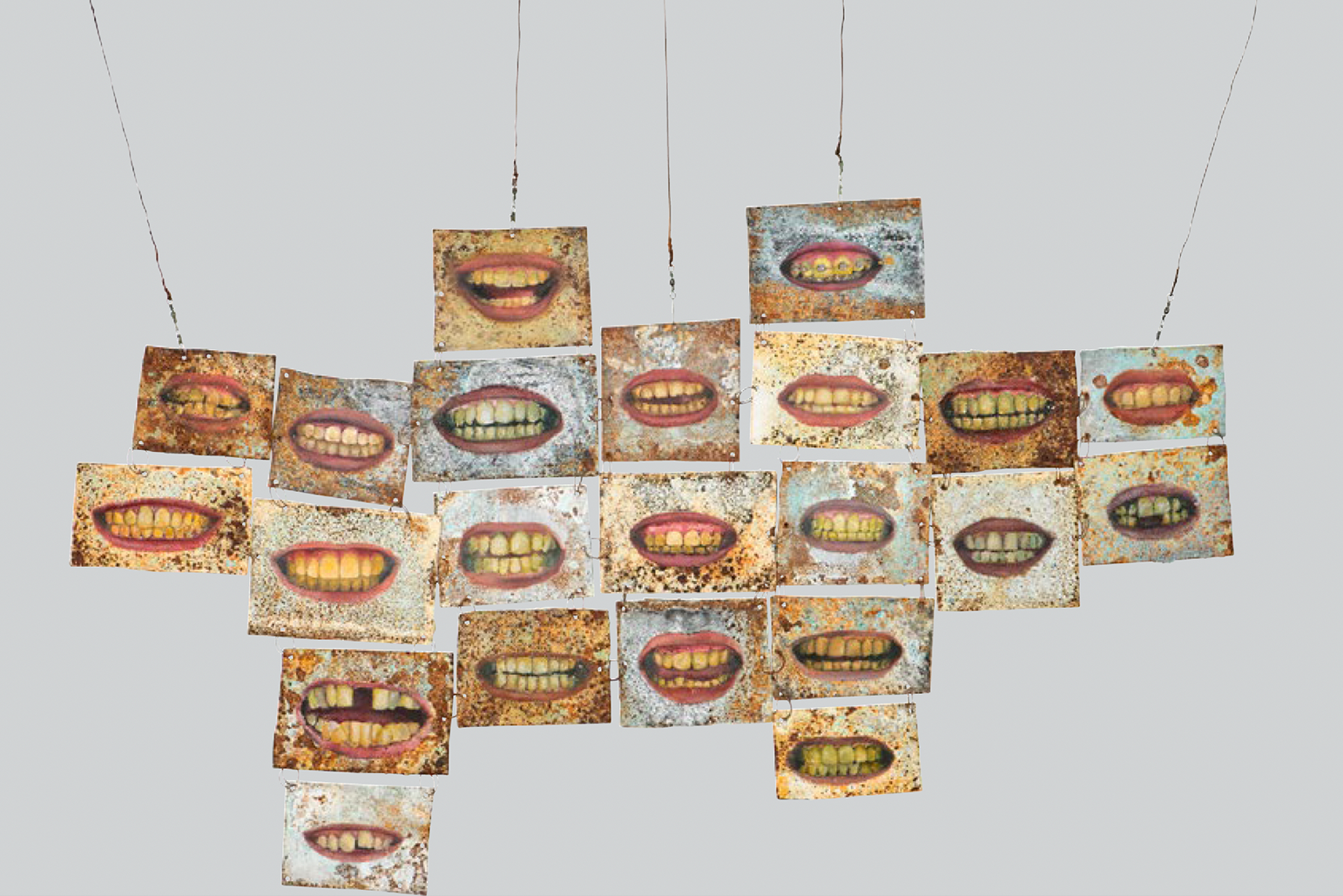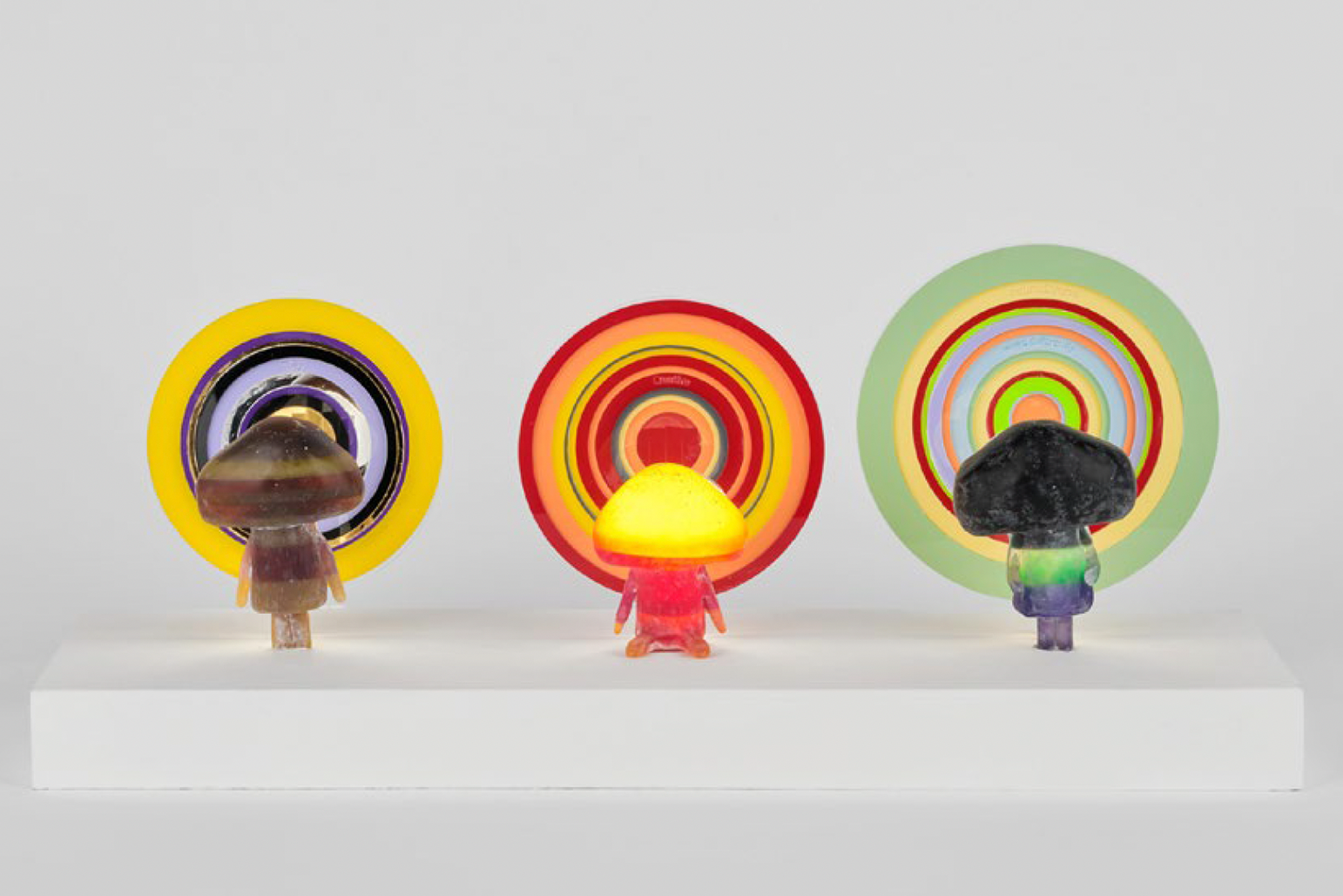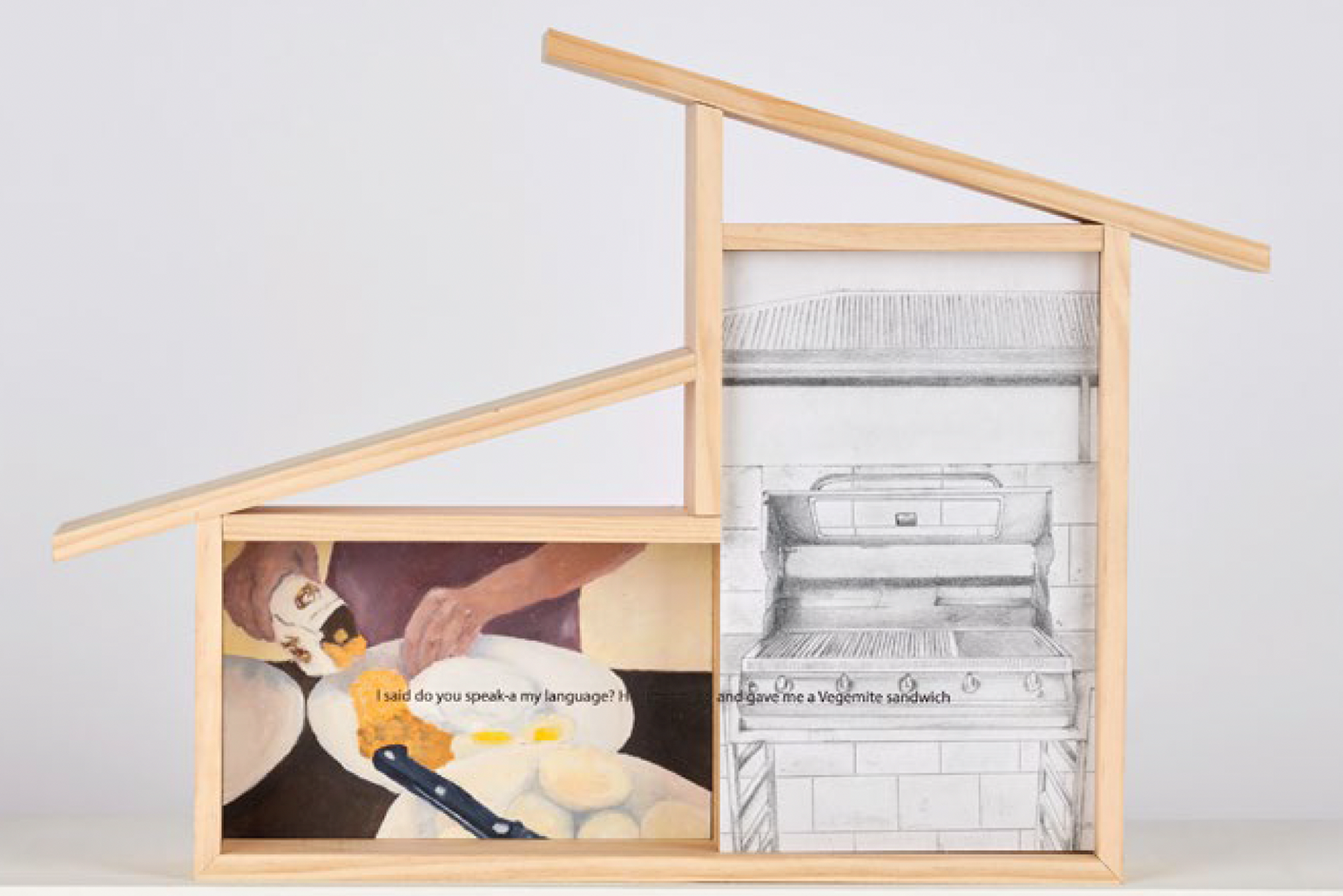


Fuck the Class System
The Art Gallery of Western Australia’s annual survey of the best of high school graduate works from around the state is among the most interesting things that happens at our state gallery, as it offers an insight into the thinking of seventeen- and eighteen-year-olds. Over the years it has moved from downstairs to upstairs and back again, and turned from a showcase of adolescent indulgence, heavy on portraits and confession, into a marvel of materiality and techniques. It has also recently changed names, from Year 12 Perspectives, to Pulse Perspectives, and now The West Australian Pulse due to sponsorship from the state’s daily newspaper. And why not? It’s an opportunity to get more money into a generally impoverished state gallery and a way for schools, albeit mostly from a particular demographic, to show off their art programs. Before moving into the issue of schools and money, let’s turn to a few of the more eye-catching works.
Georgina Godfrey’s large, self-contained installation Hardwired (Presbyterian Ladies College) is a stunning, multi-layered display of both untouched and painted polaroid photographs. It deals with issues of isolation and the prevalence of ‘social’ technologies. The polaroids appear to be suspended in mid-air, intricately and considerately layered so that different images become more prominent as the viewer moves around the work. This is made possible by a sleek, bespoke framing apparatus, which conceals the grounding points (floor and ceiling) of the clear wire, making the illusion of mid-air suspension possible.
Likewise, Zoe Huntley’s A History of the Human Smile (Methodist Ladies College) utilises methods of suspension. It uses a more humble (yet still elegant and custom made) wooden bar and thick wire display system to hang twenty-two sets of pearly white teeth above viewer’s heads in true Cheshire cat fashion (or rather a crowd of Cheshire cats). The material surface contributes significantly to the strange and eerie effect of the work, along with the selectively tarnished and exposed aluminium tiles that reflect the harsh gallery lighting. The effect is a sombre glow, inspiring admiration and curiosity in passing viewers.
In contrast, Parker Harris’s They are me, I am them (Perth College Anglican School for Girls), exudes friendliness, with a warm yellow light radiating from the colourful acrylic mushroom figures. The light is reflected by the vibrantly coloured, reflective acrylic circles which sit behind each of the three figures. While consisting of simplistic sculptural forms, this work is one of the most noticeable, even in the crowded and varied Pulse exhibition context. It is visually distinct due to the artist’s selection of materials.
Another interesting work, Matthew Menezes’s This is Australia (Christ Church Grammar School), uses traditional materials and techniques, oil painting and pencil drawing, but presents these approaches in three delicately constructed pine, sculptural frames. An innovative presentation of traditional techniques, these frames mimic the content of the work, using simple shapes to create the illusion of a universally homely and recognisable space, the epitome of Australian suburbia—triggering something recognisable from collective experiences of childhood in Australia.
These works are creative applications of materials and techniques by the individual students—and we do not wish to take away from their innovation or artistic achievements. However, we do wish to point out that, while it is easy to admire these techniques, we must be clear that they are enabled by the pulse of privilege. This privilege is visible not only in the schools that the work comes from, with parents paying between $26,000 and $31,000 annually (with the exception of scholarship students), but in the more complex materials used and the placement given to them in AGWA.
Hardwired is positioned opposite the entranceway of the show. Works containing diverse materials or techniques are then situated throughout the exhibition space like a trail of breadcrumbs, focal points between the more conventional drawings and paintings. While there may be aesthetic grounds for such curatorial decisions—especially considering that Pulse is a particularly difficult show to cohesively curate given the breadth of themes and mediums—the result is that works utilising unique materials and techniques appear, to the unassuming viewer, to be more prominently placed and, therefore, of greater artistic merit.
The few public schools who make the cut, by comparison, use cheaper and more accessible materials, consisting mostly of acrylic and oil paintings. Their works, however, are just as punchy conceptually. Gladys Hu’s A Camouflaged Soul (Melville) is a painting of a young woman struggling against red string and blue porcelain that binds and covers her. Adjacent on AGWA’s back wall is Sawdah Rennie’s The Stranger (Como), two paintings modelled on close photography of faces peering out at us from the Perth suburbs. We are less likely to see the mixing of mediums together in work from public schools, while private schools instead use everything from etched steel plates to resin, photo collages, textiles and installation.
Let’s crunch the statistics. Thirty-nine of the sixty-one students in Pulse are from private schools with annual fees in excess of $6,000, though the annual fees for most are much greater. That means 64% of selected artists are privately schooled, compared with eighteen students, around 30%, from public schools, leaving 6% who don’t fit these categories—a couple of poorer Christian schools and another whose fees aren’t advertised. This is disproportionate to enrolments. 66% of West Australian high school students are in public schools, meaning that a private school student is twice as likely to be shown in Pulse, despite there being more than twice as many students in public schools.
What we don’t have statistics on are the comparative enrolments of students in visual arts units between public and private schools. It may be that there are more students in private school art programs. What we do know, however, is that the number of students who sit and submit to the visual arts ATAR exam (which qualifies them into university) has been on a steep decline. In 2019, there were visual arts 725 ATAR students, but in 2022 there were 545. That’s an attrition rate of sixty students a year. If this was engineering or science there would surely be an outcry, but it has gone unremarked by any other media but dispatchreview.info.
Of the public school students, ten are from Gifted and Talented programs (GATE) in the visual arts, and another two from Perth Modern, an entirely GATE school. GATE are competitive entry programs that teach everything from ballet to football. Applecross, Kalamunda and Curtin receive special government funding to run visual arts programs. Six of the GATE students are from Applecross, whose program includes a Saturday morning class—an indication of how dedicated teachers and students are to the visual arts there. GATE are elite programs, but at least they are for those who qualify rather than those who can pay. We give a big shout out to the teachers and students of Como, Duncraig, Melville, Mt Lawley and Willetton who made it into Pulse, even with the advantages of the competing private schools.
Let’s not blame the judges for the unevenness of Pulse. They assess 700 entries without knowing what school the work comes from. Their decisions, however, inevitably reflect the advantages and privilege of some schools, with their better materials and resources. It would be interesting to know how many of the entries come from public schools, and how many from private, to really crunch the numbers around inequality. If there are less entries from public schools, AGWA needs to use some of that newspaper sponsorship money to pursue more entries from public school visual arts programs. If the inequality lies instead at the point of judging, then we suggest the method for judging be changed. Let’s hope that AGWA are reading, and that next year’s Pulse does not reflect the inequalities of West Australia’s school system.
The West Australian Pulse, 28 Apr – 20 Aug 2023, The Art Gallery of Western Australia.
Image credits:
1. Zoe Huntley, A History of the Human Smile, 2022, aluminium, wire, verdigris and patina solution, 103 x 120 cm.
2. Parker Harris, They are me, I am them, 2022, resin, spray paint, acrylic and LED lights 23.0 x 68.2 x 26.0 cm.
3. Matthew Menezes, This is Australia, 2022, pine wood, oil on board and drawing on paper, 40 x 55 x 9 cm.
Georgina Godfrey’s large, self-contained installation Hardwired (Presbyterian Ladies College) is a stunning, multi-layered display of both untouched and painted polaroid photographs. It deals with issues of isolation and the prevalence of ‘social’ technologies. The polaroids appear to be suspended in mid-air, intricately and considerately layered so that different images become more prominent as the viewer moves around the work. This is made possible by a sleek, bespoke framing apparatus, which conceals the grounding points (floor and ceiling) of the clear wire, making the illusion of mid-air suspension possible.
Likewise, Zoe Huntley’s A History of the Human Smile (Methodist Ladies College) utilises methods of suspension. It uses a more humble (yet still elegant and custom made) wooden bar and thick wire display system to hang twenty-two sets of pearly white teeth above viewer’s heads in true Cheshire cat fashion (or rather a crowd of Cheshire cats). The material surface contributes significantly to the strange and eerie effect of the work, along with the selectively tarnished and exposed aluminium tiles that reflect the harsh gallery lighting. The effect is a sombre glow, inspiring admiration and curiosity in passing viewers.
In contrast, Parker Harris’s They are me, I am them (Perth College Anglican School for Girls), exudes friendliness, with a warm yellow light radiating from the colourful acrylic mushroom figures. The light is reflected by the vibrantly coloured, reflective acrylic circles which sit behind each of the three figures. While consisting of simplistic sculptural forms, this work is one of the most noticeable, even in the crowded and varied Pulse exhibition context. It is visually distinct due to the artist’s selection of materials.
Another interesting work, Matthew Menezes’s This is Australia (Christ Church Grammar School), uses traditional materials and techniques, oil painting and pencil drawing, but presents these approaches in three delicately constructed pine, sculptural frames. An innovative presentation of traditional techniques, these frames mimic the content of the work, using simple shapes to create the illusion of a universally homely and recognisable space, the epitome of Australian suburbia—triggering something recognisable from collective experiences of childhood in Australia.
These works are creative applications of materials and techniques by the individual students—and we do not wish to take away from their innovation or artistic achievements. However, we do wish to point out that, while it is easy to admire these techniques, we must be clear that they are enabled by the pulse of privilege. This privilege is visible not only in the schools that the work comes from, with parents paying between $26,000 and $31,000 annually (with the exception of scholarship students), but in the more complex materials used and the placement given to them in AGWA.
Hardwired is positioned opposite the entranceway of the show. Works containing diverse materials or techniques are then situated throughout the exhibition space like a trail of breadcrumbs, focal points between the more conventional drawings and paintings. While there may be aesthetic grounds for such curatorial decisions—especially considering that Pulse is a particularly difficult show to cohesively curate given the breadth of themes and mediums—the result is that works utilising unique materials and techniques appear, to the unassuming viewer, to be more prominently placed and, therefore, of greater artistic merit.
The few public schools who make the cut, by comparison, use cheaper and more accessible materials, consisting mostly of acrylic and oil paintings. Their works, however, are just as punchy conceptually. Gladys Hu’s A Camouflaged Soul (Melville) is a painting of a young woman struggling against red string and blue porcelain that binds and covers her. Adjacent on AGWA’s back wall is Sawdah Rennie’s The Stranger (Como), two paintings modelled on close photography of faces peering out at us from the Perth suburbs. We are less likely to see the mixing of mediums together in work from public schools, while private schools instead use everything from etched steel plates to resin, photo collages, textiles and installation.
Let’s crunch the statistics. Thirty-nine of the sixty-one students in Pulse are from private schools with annual fees in excess of $6,000, though the annual fees for most are much greater. That means 64% of selected artists are privately schooled, compared with eighteen students, around 30%, from public schools, leaving 6% who don’t fit these categories—a couple of poorer Christian schools and another whose fees aren’t advertised. This is disproportionate to enrolments. 66% of West Australian high school students are in public schools, meaning that a private school student is twice as likely to be shown in Pulse, despite there being more than twice as many students in public schools.
What we don’t have statistics on are the comparative enrolments of students in visual arts units between public and private schools. It may be that there are more students in private school art programs. What we do know, however, is that the number of students who sit and submit to the visual arts ATAR exam (which qualifies them into university) has been on a steep decline. In 2019, there were visual arts 725 ATAR students, but in 2022 there were 545. That’s an attrition rate of sixty students a year. If this was engineering or science there would surely be an outcry, but it has gone unremarked by any other media but dispatchreview.info.
Of the public school students, ten are from Gifted and Talented programs (GATE) in the visual arts, and another two from Perth Modern, an entirely GATE school. GATE are competitive entry programs that teach everything from ballet to football. Applecross, Kalamunda and Curtin receive special government funding to run visual arts programs. Six of the GATE students are from Applecross, whose program includes a Saturday morning class—an indication of how dedicated teachers and students are to the visual arts there. GATE are elite programs, but at least they are for those who qualify rather than those who can pay. We give a big shout out to the teachers and students of Como, Duncraig, Melville, Mt Lawley and Willetton who made it into Pulse, even with the advantages of the competing private schools.
Let’s not blame the judges for the unevenness of Pulse. They assess 700 entries without knowing what school the work comes from. Their decisions, however, inevitably reflect the advantages and privilege of some schools, with their better materials and resources. It would be interesting to know how many of the entries come from public schools, and how many from private, to really crunch the numbers around inequality. If there are less entries from public schools, AGWA needs to use some of that newspaper sponsorship money to pursue more entries from public school visual arts programs. If the inequality lies instead at the point of judging, then we suggest the method for judging be changed. Let’s hope that AGWA are reading, and that next year’s Pulse does not reflect the inequalities of West Australia’s school system.
The West Australian Pulse, 28 Apr – 20 Aug 2023, The Art Gallery of Western Australia.
Image credits:
1. Zoe Huntley, A History of the Human Smile, 2022, aluminium, wire, verdigris and patina solution, 103 x 120 cm.
2. Parker Harris, They are me, I am them, 2022, resin, spray paint, acrylic and LED lights 23.0 x 68.2 x 26.0 cm.
3. Matthew Menezes, This is Australia, 2022, pine wood, oil on board and drawing on paper, 40 x 55 x 9 cm.
